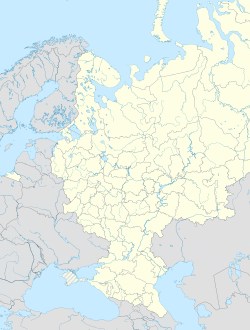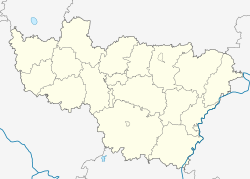Murom
| city
Murom
Муром
|
||||||||||||||||||||||||||||||||||||||||||
|
||||||||||||||||||||||||||||||||||||||||||
|
||||||||||||||||||||||||||||||||||||||||||
| List of cities in Russia | ||||||||||||||||||||||||||||||||||||||||||
Murom ( Russian Му́ром ) is a Russian city with 116,075 inhabitants (as of October 14, 2010) in the Vladimir Oblast , 290 km east of Moscow on the Moscow - Kazan railway line .
history
The city was first mentioned in a document in 862 and takes its name from the Finno-Ugric tribe of Muroma , who settled the area of today's Murom in the 6th century. From the 10th century, the place became part of the Kievan Rus and, thanks to its location on the Oka, quickly developed into an important trading center. At that time a Kremlin was built there on the banks of the Oka , a fortress surrounded by wooden walls with a total of eleven towers, which stood there until the end of the 18th century and was then dismantled on the instructions of Catherine the Great .
In 1097 an independent principality of Murom-Ryazan broke away from the Principality of Chernigov . In 1239, during the Mongol invasion of the Rus, the troops of the Golden Horde under Batu Khan appeared outside the city gates. As a result, Murom was devastated and burned down.
In 1393 Murom was incorporated into the Grand Duchy of Moscow after Grand Duke Vasily I Dmitrijewitsch was granted rule over the Principality of Murom by the rulers of the Golden Horde. Several churches were built here under Tsar Ivan the Terrible , which can still be visited today, including the Annunciation Cathedral from 1553, which Ivan had Moscow builders built in memory of his army's victory over the Kazan Khanate . The Cosmas and Damian Cathedral, built by Pskov builders, also dates from the same period .
At the beginning of the 17th century, Murom, like many other cities around Vladimir, was heavily devastated in a Polish-Lithuanian attack. It was not until the middle of the century that the city was able to recover and repair damaged structures. A few more monasteries and several industrial companies emerged, including metalworking and leather factories and an arms factory, the masters of which have earned an excellent reputation in the Russian Empire over the years. Some of the products of the Muromer weapons factory that were specially made for the tsars are exhibited in the armory of the Moscow Kremlin to this day . At the same time, thanks to its connection to the Volga , Murom again developed into a commercial center. Measurements in the late 18th century counted a total of 552 buildings, 18 stone and 16 wooden churches in Murom with around 2750 inhabitants.
At the end of the 18th century, Catherine the Great had a general building plan drawn up for Murom, which received city rights in the course of the regional reform in 1778, which provided for the construction of buildings in the classical style. Some of these projects were also implemented in the decades that followed and to this day - alongside the medieval church buildings - are among the most famous buildings in the city, including a water tower and the building of the trading rows.
In 1912 Murom experienced another boom with the opening of the railway connection from Moscow to Nizhny Novgorod . Murom received a train station on this route with a reception building, which is stylistically linked to the non-preserved Murom Kremlin. The station building was designed by the architect Alexei Shtusev , who also designed several other well-known stations in Russia (including the Kazan station in Moscow).
Since Murom was spared the destruction in World War II , it is one of the best preserved old Russian cities today. The city continued to develop architecturally in the second half of the 20th century; One of the most famous buildings of this time is the city theater building from 1962, which was based on the old Russian architecture and therefore complements the historical ensemble of the old town of Murom well.
Population development
| year | Residents |
|---|---|
| 1897 | 13,271 |
| 1939 | 40,079 |
| 1959 | 71,567 |
| 1970 | 98,839 |
| 1979 | 114,270 |
| 1989 | 124.229 |
| 2002 | 126.901 |
| 2010 | 116.075 |
Note: census data
Economy and Transport
Today Murom has an inland port and a railway junction, the most important branches of industry are mechanical engineering, wood and textile industry.
Murom's economy benefits from its proximity to Moscow. The most important branches of industry are: mechanical engineering, radio technology, food production and wood processing, but also the textile industry in the area of weaving. There are currently over 20 major privatized companies in the aforementioned industries. In the agricultural sector, the main focus is on livestock and plant breeding. The goods produced are also sold in Europe and the rest of the world.
The city is well connected to the main roads and railways in the area. The city can be easily reached from Moscow by train, bus or car. National and international flights are handled via the airports in Moscow. The city is connected by waterways via the Oka River , a tributary of the Volga.
Attractions in Murom
- Cosmas and Damian Church (16th century)
- Annunciation Cathedral (1553)
- Trinity Monastery (17th century)
- Resurrection Monastery (1650s)
- Ascension Church (1729)
- Classicist buildings from the 18th-19th centuries Century, including the water tower and the trading house
- Monument to the bogatyr Ilya Muromets , who is said to have been born near Murom
- Sworykin House (1840), now a local museum
- Station building (1912)
- Picture gallery (1919)
Education and culture
Murom has a culture palace , which was built for the 1100th anniversary of the city, a house of folk art , three culture houses, a culture and history museum, three music schools, a youth art school and several libraries and parks.
In addition to the primary schools, Murom has a pedagogical college, a medical school, three technical vocational schools, a radio technical center and two youth sports schools.
Further educational institutions in Murom are:
- Murom Institute of Vladimir State University
- Murom branch of the Moscow Faculty of Psychology and Social Sciences
Town twinning
Murom has partnerships with the following cities:
sons and daughters of the town
- Sergei Prokudin-Gorski (1863–1944), pioneer of color photography
- Anatoli Ryabinin (1874–1942), geologist and paleontologist
- Ivan Kulikow (1875–1941), portrait and genre painter
- Dionizy (1876–1960), Metropolitan of the Polish Orthodox Church
- Alexander Schljapnikow (1885–1937), trade unionist and politician
- Vladimir Zworykin (1888–1982), Russian-American engineer, physicist and inventor
- Kosso Eloul (1920–1995), Israeli-Canadian sculptor
- Viktor Lossew (* 1959), football player and coach
- Sergei Schipow (* 1966), chess master, journalist and author
- Sergei Karavaev (* 1968), boxer
literature
- Zinaida Pastuchova, Elena Ponomarëva: Drevnerusskie goroda . Rusič-Verlag, Smolensk 2006, ISBN 5-8138-0470-6 , pp. 250-267
Web links
- Murom on mojgorod.ru (Russian)
- City and regional portal Murom (Russian)
- Murom Art History Museum (Russian)
Individual evidence
- ↑ a b Itogi Vserossijskoj perepisi naselenija 2010 goda. Tom 1. Čislennostʹ i razmeščenie naselenija (Results of the All-Russian Census 2010. Volume 1. Number and distribution of the population). Tables 5 , pp. 12-209; 11 , pp. 312–979 (download from the website of the Federal Service for State Statistics of the Russian Federation)






